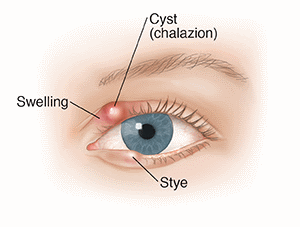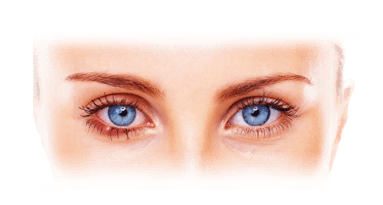Chalazion & Stye
A stye (also called a hordeolum) is a small, red, painful lump that grows from the base of your eyelash or under the eyelid. Most styes are caused by a bacterial infection.
A chalazion is a swollen bump on the eyelid. It happens when the eyelid’s oil gland clogs up. It may start as an internal hordeolum (stye).
At first, you might not know you have a chalazion as there is little or no pain. But as it grows, your eyelid may get red, swollen, and sometimes tender to touch. If the chalazion gets large, it can press on your eye and cause blurry vision. Rarely, the whole eyelid might swell.
Difference Between Stye and Chalazion

Sometimes it can be difficult to tell the difference between a stye and a chalazion.
A stye is very painful. It often appears at the eyelid’s edge, usually caused by an infected eyelash root. It often swells, sometimes affecting the entire eyelid.
A chalazion is not usually painful. It is a bump that usually develops farther back on the eyelid than a stye. It is caused by a clogged oil gland. Rarely does it make the entire eyelid swell.
Symptoms
Stye symptoms can include:
- A very painful red bump along the edge of the eyelid at the base of the eyelashes. It may make the entire eyelid swell.
- Usually a small pus spot at the center of the bump.
- Feeling like something is in your eye.
- Having a scratchy feeling in the eye.
- Being sensitive to light.
- Crustiness along the eyelid margin.
- Tearing in that eye.
A chalazion can develop and you might not see any symptoms. When there are symptoms, they can include:
- A bump on the eyelid, sometimes becoming red and swollen. Occasionally it can be tender.
- Rarely, an entirely swollen eyelid.
- Blurry vision, if the chalazion is large enough to press on the eyeball.

Chalazia and Stye Treatment Options
Warm compresses: Soak a clean washcloth in hot water and hold it to your eyelid for 10–15 minutes at a time, 3–5 times a day. Keep the cloth warm by soaking it in hot water often. For a chalazion, this warm compress helps the clogged oil gland to open and drain. You can help the gland clear itself by gently massaging around the area with your clean finger.
Antibiotics: Our ophthalmologist may prescribe an antibiotic for an infected stye.
Steroid shots: If your chalazion is very swollen, our ophthalmologist may give you a steroid shot (cortisone) to reduce the swelling.
Surgery to drain the area: If your stye or chalazion affects vision or does not go away, you may need to have it drained. This surgery is usually done in the doctor’s office using local anesthesia. If a stye or chalazion keeps coming back time after time, our ophthalmologist may biopsy it. This is where a tiny piece of tissue is removed and studied. This helps our ophthalmologist check to see if there is a more serious eye problem.
Do not squeeze or try to pop a stye or chalazion!!! Doing so could spread the infection into your eyelid. Do not wear eye makeup or contact lenses while you have a stye or chalazion.







